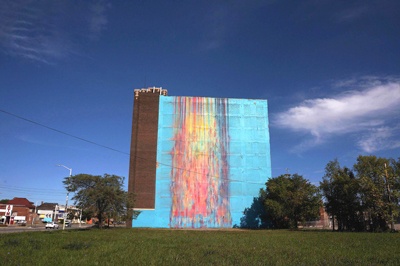Last year we bemoaned a lost opportunity when a preliminary injunction concerning a mural on the Prado Dam in California was decided under what seemed to us to be a misunderstanding of the Visual Artists Rights Act of 1990, 17 U.S.C. § 106A ("VARA"). Although a preliminary injunction was eventually entered on other grounds concerning historic preservation statutes, the court joined a long line of decisions that seemed not to understand or unwilling to apply what VARA actually says. Given the rarity with which VARA claims actually get to court, it was a frustrating lost chance for some badly needed interpretive guidance.
A new lawsuit may provide that chance. Artist Katherine Craig has filed suit in Michigan against the owner of a building on which her Illuminated Mural is painted. In a press release that accompanied the filing Craig stated "The Illuminated Mural is an essential artwork, both for me as an artist and for the North End community. I'm bringing this lawsuit to stand up for the rights of artists everywhere, and for the interests of Detroit's creative entrepreneurs, like myself, who have invested in the arts, public art and art education."

Above: A photograph of the mural that her representatives provided to the Art Law Report
It is a captivating, even arresting work. As detailed in the Complaint, Craig alleges that her mural was painted in 2009, measuring 100' x 125' on the side of 2937 East Grand Boulevard in Detroit's North End. She reached an agreement with the then-owner of the building, Boydell Development Corporation. The Complaint alleges that the agreement with Boydell specified that the work would remain on the building for at least ten years. She then proceeded to paint the mural.
As Craig describes it, the mural has received national attention:
The Detroit Free Press included The Illuminated Mural in a 2015 guide to the city's best street art, calling it 'maybe Detroit's most drop-dead gorgeous mural.'. . . It has been featured nationally in the documentary 'Detroit Lives,' from Vice Media, and the music video for "Come Fly Away," by the English-Irish singer Maverick Sabre.
The challenge is that the building has had multiple owners since then. Current owner Princeton Enterprises LLC purchased the building in January 2015, according to the Complaint. As the Complaint alleges, Princeton Enterprises is considering redevelopment options that include destroying the building (and the mural).
Craig's lawsuit argues that Illuminated Mural is a work of "recognized stature" within the meaning of VARA. If it is, that grants to Craig, the artist, the "right of integrity"—the right to prevent the physical alternation of her work, even if she no longer owns it. 17 U.S.C. § 106A(a)(3)(A)-(B) states:
(3) subject to the limitations set forth in section 113(d), shall have the right—
(A) to prevent any intentional distortion, mutilation, or other modification of that work which would be prejudicial to his or her honor or reputation, and any intentional distortion, mutilation, or modification of that work is a violation of that right, and
(B) to prevent any destruction of a work of recognized stature, and any intentional or grossly negligent destruction of that work is a violation of that right.
These provisions of VARA are very much at odds with common understandings of property rights, but they have been the law for more than 25 years. If the 5Pointz case is any guide one would expect the litigation to turn on that question of recognition, but in a common-sense way the mural certainly seems to fit that standard. Whereas the 5Pointz judge was not persuaded that any single work of graffiti qualified, Craig's mural is clearly a unique work that has been recognized as such by critical media.
Also important will be the terms of the original agreement with Boydell. This is not a graffiti mural, it was painted with express permission of the then-owner. VARA rights are very hard to waive, and Craig alleges specifically that she has never done so. But particularly given how many courts have stampeded over the statute's language, a commercial agreement could end up being extremely important as a license. A factual question will be whether the sales of the building made any reference to that agreement, a process known as "assignment." At the very least Craig could argue that even independent of VARA the agreement guarantees at least 10 years of security for the mural.
Craig makes a straightforward and appealing case for VARA protection. How the owner responds will be interesting.



